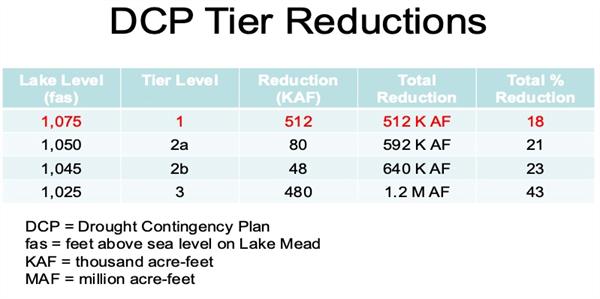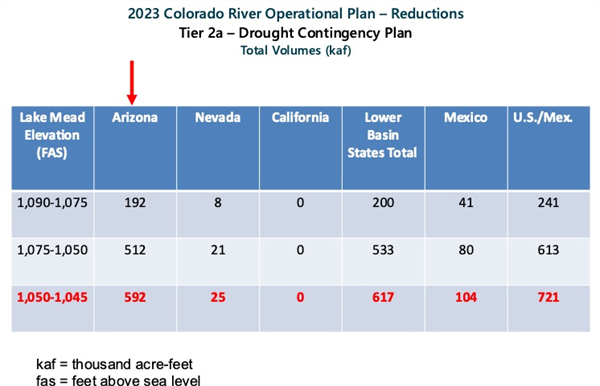
As Colorado River flows have decreased over the past 23 years due to the prolonged drought, many proposals have been presented for management of the river. One group from the research community presented some intriguing scenarios last year with a publication in Science on 22 July 2022 (Wheeler et al., 2022).
I found some of their points and suggestions interesting in relation to the Colorado River management discussions. These recommendations are not reflected in the recent U.S. Bureau of Reclamation (USBR) operational plans for 2024 that were presented with their 24-Month study reports and projections (USBR, 15 August 2023). It will be interesting to see if these points become part of the negotiations in the next two years for the interstate and international shortage agreements that expire in 2026.
Basic parameters for any proposed management plans of the Colorado River must include the “Law of the River” which is an amalgam of interstate compacts, court decrees, federal laws, secretarial guidelines, and an international treaty with Mexico. Key elements associated with the Law of the River include the 1922 Colorado River Compact among the seven basin states in the United States and the 1944 Treaty between the United States and Mexico.
The 1922 Colorado River Compact divided the watershed into upper and lower basins with the dividing point at Lees Ferry in Arizona. Each basin was allocated 7.5 million acre-feet (MAF) per year. The 1944 Treaty established a delivery requirement of 1.5 MAF/year to Mexico. Thus, a total of 16.5 MAF/year is allocated from the Colorado River.
The 1922 Compact negotiators based their work on an assumption of 17.5 MAF/year of river flow. However, the 20thcentury average natural flow rates on the Colorado River have been 15.2 MAF/year, resulting in an approximate 2.3 MAF/year structural deficit. This deficit in the water budget for the Colorado River and evaporation losses were never corrected in a formal manner, primarily due to some states not using their full allocations.
Changes in the climate since 2000 have resulted in much drier conditions in the Colorado River watershed with reduced annual natural flows to an average of 12.3 MAF/year. Thus, the challenge in addressing the shortages on the Colorado River is that of basic mass balance and developing a consumptive use water budget that matches water supply in the river.
Like many people working in agriculture, I have been watching and studying the situation with great interest. Based on my understanding, one of the key issues in the negotiations has been the differences in perspectives between the upper and lower basin states.
The lower basin states and Mexico have been fully utilizing their water allocations from the Colorado River in contrast to the upper basin which has not been using its full 7.5 MAF/year allocation. For example, between 2000 and 2020 the upper basin consumptive use averaged 3.7 MAF/year plus at least 0.7 MAF/year of reservoir evaporation. The upper basin states have plans for further development and utilization of their full allocation and they want to protect their Colorado River water allocation to support these development plans.
Agriculture is responsible for approximately 70% of the Colorado River water use. As noted by the USBR (2015), the lower basin has been irrigating less than one-half of the area irrigated by the upper basin, but the agricultural revenues of the lower basin are more than three times that of the upper basin.
Additional upper basin development and water use from the river exposes a much higher level of uncertainty on Colorado River water management for the future and there are concerns that it could violate the non-depletion obligation in the 1922 Compact which states the upper basin will not deplete the river’s flow to less than 75 MAF during any 10-year consecutive period. This implies an assumption on the part of the 1922 Compact negotiators that a short-term drought could be managed within a 10-year period, but we are now dealing with drought extending over 23 years. In addition, the 1944 Treaty requires all seven states to share in the obligation to Mexico.
The upper basin states have been adamant that the responsibility of balancing the shortages on the river rests fully with the lower basin states and Mexico. The upper basin states have also consistently emphasized the importance of equality between basins as outlined in the Compact but that has not actually happened in 100 years.
The upper basin representatives have proposed reductions in lower basin water use of 1.2 – 1.5 MAF, which is a reduction of about 17-22%. In addition, upper basin states suggest that evaporation losses from the river system should be subtracted out of the lower basin allocations.
On the other hand, important economic and equity considerations must also be recognized and a good argument exists that the loss of an established agricultural industry in the lower basin is much more harmful than reducing plans for future development in the upper basin. Thus, the proposed development in the upper basin is being questioned and appropriately so in my view.
Wheeler et al. (2022) ran a series of hydrological models, including the USBR Colorado River Simulation System (CRSS, 2021) and developed a set of 100 scenarios. More details are provided in their article (Wheeler et al., 2022).
In my review of the work presented by Wheeler et al., there are two scenarios that are particularly intriguing, outlined in Tables 1 and 2.
|
Basin |
Proposed Consumptive Use |
Percent of Full Allocation |
|
Upper |
4.5 |
60% of full allocation and0.8 MAF > recent use |
|
Lower |
6.0 |
66.7% of full allocation |
Table 1. The first scenario presented in the Wheeler et al. (2022) article.
|
Basin |
Proposed Consumptive Use |
Percent of Full Allocation |
|
Upper |
4.0 |
53% of full allocation and0.3 MAF > recent use |
|
Lower |
7.0 |
77.8% of full allocation |
Table 2. The second scenario presented in the Wheeler et al. (2022) article.
Both scenarios represent significant reductions in Colorado River water allocations to balance consumptive use with recent natural flow rates. But the fact remains that the mass balance of natural Colorado River flow and consumptive must be dealt with to realize a sustainable system of management. All these scenarios present major challenges in implementation.
For 2024, the operational plans for the Colorado River are basically the Tier 1 plans from the 2019 Drought Contingency Plan (USBR, 2023; Table 3). Tier 1 reductions include an 18% reduction in Colorado River water use by Arizona and approximately 3 MAF of additional water is being held in Lake Mead by voluntary reductions from several Arizona municipalities.
In 2023, Tier 2a guidelines were in effect in 2023 and Arizona has been dealing with a 592,000 AF allocation, which is a 21% reduction of the 2.8 MAF full allocation (Table 4). Thus, Arizona, Mexico, and other lower basin states have already been meeting the reduction requirements outlined in the second scenario described above (Table 2).

Table 3. Drought Contingency Plans (DCP) for Arizona, Tiers 1-3. Tier 1
reductions (red) will be in place in 2024.

Table 4. Drought Contingency Plan for lower basin states and Mexico, rows are
Tier 0, Tier 1, and Tier 2a. Arizona is highlighted with the red arrow and Tier 2a
for all lower basin states and Mexico in red letters.
The consideration of scenarios such as the ones described by Wheeler et al. offer some good points for consideration over the next two years as all interstate and international shortage agreements expire in 2026. The negotiations in the next two years will be challenging and any proposal offered will meet resistance, particularly under the conditions of the Colorado River after 23 years of serious drought and the high level of demand that exists in the basin.
Reference
USBR. 2015. “Moving Forward Effort: Phase 1 Report” (DOI, May 2015); https://www.usbr.gov/lc/region/programs/crbstudy/MovingForward
USBR. 2021. “DRAFT CRSS: Key modeling assumptions, June 2021 model” (DOI, 2021); http://bor.colorado.edu/Public_web/CRSTMWG/CRSS.
USBR, 15 August 2023. 24-Month Study reports.
August 2023 Lake Powell and Lake Mead: End of Month Elevation Charts
Wheeler, K.G., B. Udall, J. Wang, E. Kuhn, H. Salehabadi, and J. C. Schmidt. 2022. What will it take to stabilize the Colorado River? Science, 377 (6604), DOI: 10.1126/science.abo4452
https://www.science.org/doi/10.1126/science.abo4452c
I hope you are frolicking in the fields of wildflowers picking the prettiest bugs.
I was scheduled to interview for plant pathologist position at Yuma on October 18, 2019. Few weeks before that date, I emailed Dr. Palumbo asking about the agriculture system in Yuma and what will be expected of me. He sent me every information that one can think of, which at the time I thought oh how nice!
When I started the position here and saw how much he does and how much busy he stays, I was eternally grateful of the time he took to provide me all the information, especially to someone he did not know at all.
Fast forward to first month at my job someone told me that the community wants me to be the Palumbo of Plant Pathology and I remember thinking what a big thing to ask..
He was my next-door mentor, and I would stop by with questions all the time especially after passing of my predecessor Dr. Matheron. Dr. Palumbo was always there to answer any question, gave me that little boost I needed, a little courage to write that email I needed to write, a rigid answer to stand my ground if needed. And not to mention the plant diagnosis. When the submitted samples did not look like a pathogen, taking samples to his office where he would look for insects with his little handheld lenses was one of my favorite times.
I also got to work with him in couple of projects, and he would tell me “call me John”. Uhh no, that was never going to happen.. until my last interaction with him, I would fluster when I talked to him, I would get nervous to have one of my idols listening to ME? Most times, I would forget what I was going to ask but at the same time be incredibly flabbergasted by the fact that I get to work next to this legend of a man, and get his opinions about pest management. Though I really did not like giving talks after him, as honestly, I would have nothing to offer after he has talked. Every time he waved at me in a meeting, I would blush and keep smiling for minutes, and I always knew I will forever be a fangirl..
Until we meet again.
Interested in staying up to date on the latest robotic ag technologies? FIRA USA is hosting a 3-day Robotics and Autonomous Farming Solutions in Action Forum September 19-21st in Salinas, CA. The focus is on autonomous farming and agricultural robotic solutions. The event includes high-level keynote speakers, breakout sessions, a trade show and in-field demos of automated/robotic planting, weeding and harvesting equipment. Last year’s conference was excellent with informative presentations/panel discussions, plenty of time to network, 20 robots on display and top-level company representatives on hand to answer questions. This year’s program looks to be outstanding as well with over 25 robots and 12 robot demos scheduled already. For more information, visit https://fira-usa.com/.

We have recently received winter grass samples for identification and one of the most common has been Annual Bluegrass (Poa annua). Native to Europe it is distributed worldwide we find it invading homeowner landscapes, golf courses, and agricultural fields. It reproduces only by seeds1 and can have several generations per year. The leaf blades are about 3 in long and plants are about 4 to12 inches tall. The flowering part is about 1to 4 inches long There are several species of the genus Poa but we included in this article the most typical characteristics of the Poa annuaspecies3.
Please check the highlighted features of this grass in the illustrations below:
When leaves are looked through light two transparent lines on both sides of the midrib can be seen 2

Figure1. Key characteristics of annual bluegrass. (Images: M. Peña and Jim
Converse Proturf Guide to the Identification of grasses).

Figure 2. Proturf Guide to The Identification of Grasses, Jim Converse
References: